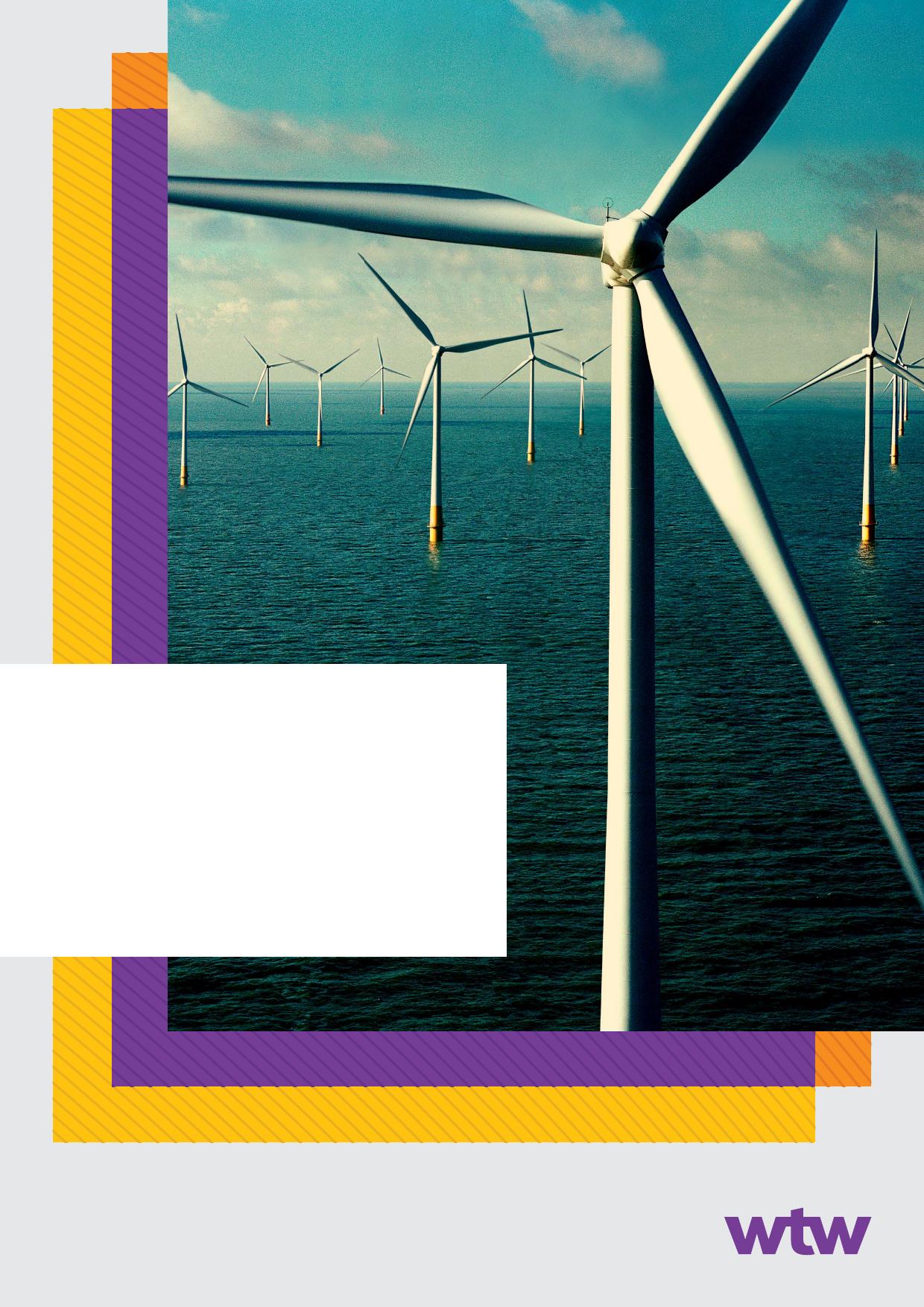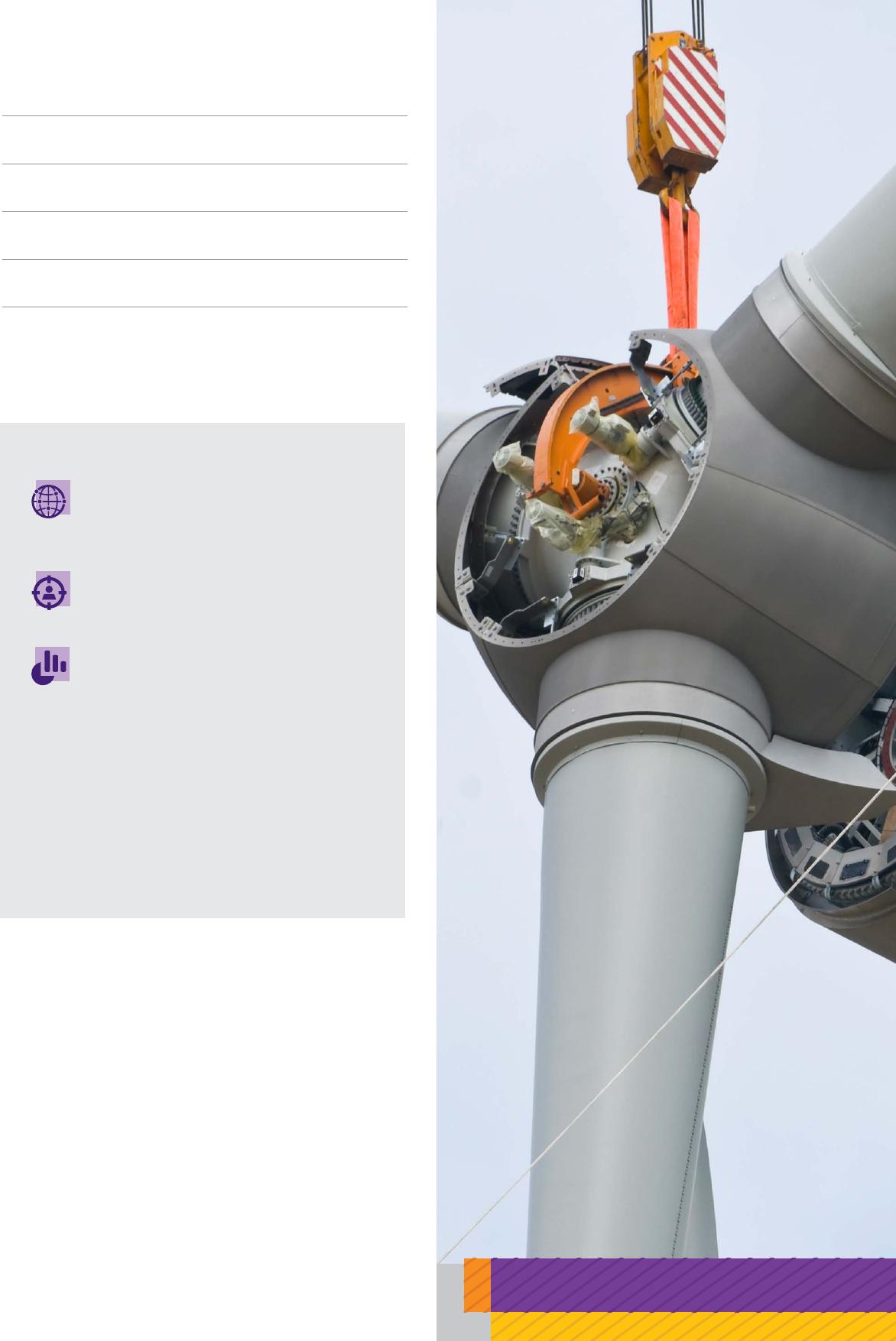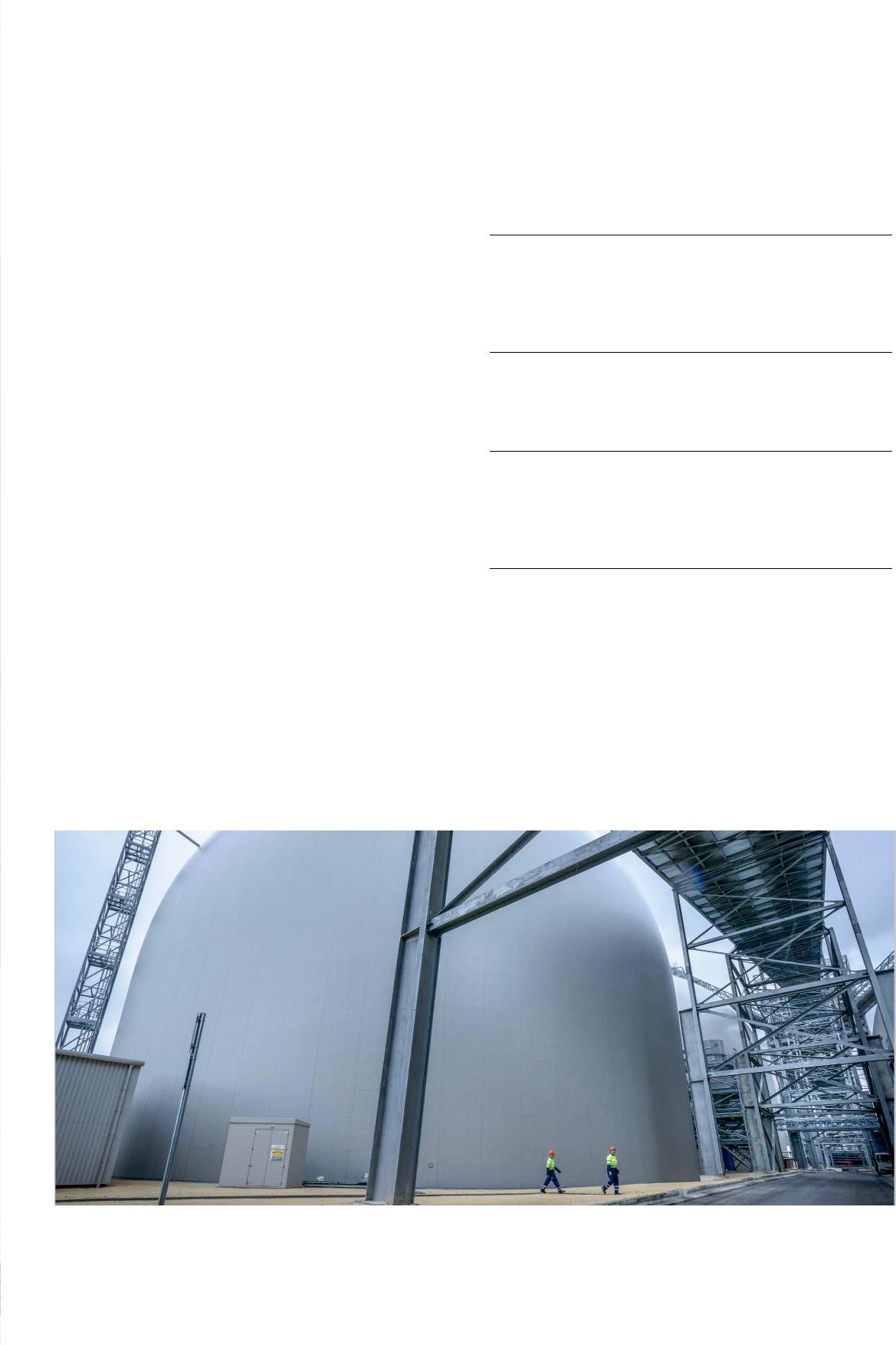wtwco.com2023RenewableSupplyChainRiskReportWTWGlobalSupplyChainSurveyTABLEOFCONTENTSIntroductionandkeyfindings03Marketoverview04Risklandscape06Riskmanagementandresilience09Surveysampleandmethodology142/WTWGlobalRenewablesSupplyChainRiskReportAboutthesurveyWho:100seniordecisionmakers,includingriskmanagers,supplychainandlogisticsmanagersandCEOs.Where:CountriesacrossEurope,NorthAmerica,Asia-PacificandLatinAmerica.Size:Allcompaniessurveyedhadannualrevenueover$250million.Findfulldetailsofoursampleandmethodologyonpage14.Thesurveycontainedallclosedquestionswithdifferentresponseoptionsrangingfromrankingquestionsandmulti-selecttosinglecodedquestions.Inthisreport,wehaveincludedsomeofthefindingsfromthesurvey.Forthefullresults,includingbreakdownsbyregionandjobrole,pleasecontactususingthedetailsonpage15.WTWGlobalRenewablesSupplyChainRiskReport/3IntroductionAfteryearsofexponentialgrowth,renewablesmaybeclosetoatippingpointwhentheybecomethemainsourceofenergypoweringeconomiesandindustries.Supplychainshavebeencentraltothissuccess,deliveringthetechnologiesandeconomiesofscaleneededtomaketheenergytransitionpossible.Buttherearesignsthatthisprogresscouldbestalling,atleasttemporarily.Risingrawmaterialpricesarereversingthedownwardtrendinthecostofrenewables,whileshortages,bottlenecksanddelaysinthesupplychainarelengtheningprojectleadtimes,puttingfutureplansatrisk.Howareenergybusinessesadapting?Tofindouthowthesectorisnavigatingthischanginglandscape,wesurveyed100riskandsupplychainleadersincompaniesprovidingtechnologies,infrastructureandpowergenerationinareasincludinghydro,solar,wind,biofuels,geothermal,batterystorageandheatpumps.Howdotheyseethesupplychainlandscape?Whatarethemainchallengesandriskstheyface?Whataretheydoingtoovercomeobstaclesandtotrytobuildresilience?Andwhatwillthesupplychainsofthefuturelooklike?Fivekeyfindings74%ofbusinessessaidlossesrelatedtothesupplychainhadbeenhigherormuchhigherthanexpectedoverthelasttwoyears.44%namedashortageofrawmaterialstobeamongthebiggestsupplychainfactorsexpectedtoimpacttheirbusinessesoverthenexttwoyears,toppingthelistofconcerns.84%saidtheyhavemadeatleastsomeimprovementsintheirapproachtosupplychainmanagementinresponsetothepandemic.85%saidalackofdata,knowledgeandunderstandingwereamongthefactorsposingthegreatestchallengetoaddressingrisksoverthenextthreetofiveyears.80%agreedorstronglyagreedthatalackofalternativesuppliersimpededtheirabilitytoimplementaneffectivedualormulti-sourcestrategy.4/WTWGlobalRenewablesSupplyChainRiskReportSupplychainproblemsholdbackrenewablesprogressMarketoverviewThere’snodoubtthatrenewablesarethefutureofenergy.Ifclimatechangewasnotenoughtomotivateaswitchfromfossilfuels,theconflictinUkrainehasstarklyhighlightedthevolatilityofoilandgas,bothintermsofcostandreliabilityofsupply.Buttherearequestionsoverhowfarandhowfasttheenergytransitionwillgo.Evenifthepoliticalwillandeconomicincentivesforrenewablesarealigned,supplychainsmaystruggletodelivertheinfrastructureandequipmentneededtomakethishappenattherequiredpace.Heavilyimpactedbythepandemic,theyarenowbeingtestedbyrisingrawmaterialcostsandcapacityconstraints.Surgesincommoditypricessuchassteelhaveinflatedthecostofinfrastructuresuchaswindturbines,whilethegrowthofsolarenergyhasbeenconstrainedbyshortagesofmaterials,tradetariffsandalackofskilledlabor.Thesectoralsofacesshortagesofcriticalmineralssuchaslithium,cobalt,nickel,graphiteandcopper,neededforcleanenergytechnologies.Allofthesefactorsarecontributingtohighercostsandlongerleadtimes,makingprojectslessviableinthenearterm.FirmspayahighcostfordisruptionGiventhesechallenges,it’sperhapsnotsurprisingthatalmostthree-quartersofrespondents(74%)inoursurveysaidthattheirlossesrelatedtosupplychainriskwerehigherormuchhigherthanexpectedoverthelasttwoyears.Itappearstheissueshavebeenbuildingforsometime—alargeproportion(40%)agreedorstronglyagreedthatsupplychainsriskshadbeenincreasingbeforethepandemic.However,experiencesandlearningsfromthelastfewyearshavemotivatedbusinessestoincreaserobustnessandresilience.Amajorityinthissurvey(64%)saidtheyhavemadesomeimprovementsintheirapproachtosupplychainmanagementfollowingthepandemic.Afurther20%saidtheyhavecompletelytransformedtheirapproach.CollaboratingtoreducerisksandlossesWhenaskedaboutthegreatestopportunitiestoimprovesupplychainmanagement,increasedcollaborationwithcustomers(53%)cametopofthelist,followedbystrategicplanningwithintheirorganization(51%)andincreasedcollaborationwithsuppliers(51%).Theseresultsunderlinetheneedtoworkcloserwithkeypartnerstooptimizecurrentsupplychainswhereswitchingsuppliersisoftennotanoption.Thevastmajority(80%)agreedorstronglyagreedthatalackofalternativesuppliersimpededtheirabilitytoimplementaneffectivedualormulti-sourcestrategy—higherthananyotherindustryinourGlobalSupplyChainsurvey.Q:Whichofthefollowingbestdescribestheextentofyourbusiness’ssupplychainrisk-relatedlossesinthelasttwoyears?Top2box(Net):Renewables:74%MuchhigherthanexpectedHigherthanexpectedAboutwhatexpectedLowerthanexpectedMuchlowerthanexpectedFigure1:Supplychainrisk-relatedlossesinthelasttwoyears0%60%50%40%30%20%10%22%52%21%3%2%Q:Whichofthefollowingbestdescribeswhatimpact,ifany,COVID-19hadonyourorganization’sapproachtosupplychainmanagement?Wehavecompletelytransformedourapproachfollowingthepandemic.Wemadesomeimprovementstoourapproachfollowingthepandemic.Itdidnotchangebecausewehadotherpriorities.Itdidnotchangebecausewealreadyhadarobustapproachinplace.Figure2:ImpactofCOVID-19onapproachtosupplychainmanagement13%3%20%64%WTWGlobalRenewablesSupplyChainRiskReport/5Q:Whichofthefollowingofferthegreatestopportunitiesintermsofenhancingyoursupplychainmanagement?Ranktop3Figure3:GreatestopportunitiesintermsofenhancingsupplychainmanagementIncreasedcollaborationbetweenyouandyoursuppliersImprovedstrategicplanningwithinyourorganizationMoresophisticatedmodellingAvailabilityofmoreandhigherqualitydataHybridandothernewwaysofworking53%42%51%35%51%35%33%“Themarketopportunityinrenewablesisvast.Wind,solarandbatterytechnologiesthatwereintheirinfancyattheturnofthemillenniumhavegrownintolargescaleglobalindustries.Nevertheless,theystillhavealotofuntappedpotential.Recordinvestmentisnowgoingintosecuretheenergytransition,forexamplethroughtheU.S.InflationReductionActandsimilarprogramsintheEU.However,gettingtherewon’tbeeasy.Forthefirsttimeinyears,thecostofrenewablesisgoingupinsteadofdown.Thepriceofsomerawmaterialshasmultiplied,drivenbyinflationandcompetitionforresources.Thisreversesalong-termdownwardtrendachievedthroughtechnologicaladvancesandeconomiesofscale,makingcleanenergytransitionsmoredifficultandcostly.Suppliersandcontractorsfacecapacitychallenges,aswellasshortagesofmaterialsandskilledworkers.Theresultisthatleadtimesfordeliveringkeyequipmenthavedoubledinsomecases.Thecostofinsuringprojectshasalsoincreasedasvaluesandpossiblelossesarehigherandlongerindemnityperiodsareneededtocoverthem.Addedtothesepressures,theproductionofkeyrawmaterials,mineralsandcomponentsisconcentratedincountriesaffectedbyconflictandgeopoliticaltensions.Thiscouldbecomeacrunchissueinthecomingyearsasdemandforcertaincriticalmineralsisforecastedtorisebyupto500%.Tomitigatesomeofthesechallenges,companiesshouldconsidercarryingoutreviewswithsuppliers,improvingandclarifyingthetermsofframeworkagreements,andobtainingfullvisibilityofhowandwhererawmaterialsandequipmentarebeingproduced.Theyshouldalsolooktodiversifysupply,recyclecomponents,rawmaterialsandbuildingmaterials,andbuildbufferstockstosafeguardagainstfuturedisruptionwhereverpossible.”StephenMundayGlobalRenewableEnergyLeader,NaturalResourcesGlobalLineofBusiness,WTWExpertview:supplychainsshowingthestrainofrapidgrowthandchange0%60%50%40%30%20%10%IncreasedcollaborationbetweenyouandyourcustomersDigitaltransformation60%Chinaaccountsfor60%ofglobalturbinecapacityandhalfoftotalexports,aswellasalargeproportionofsolarpanels,batteriesandheatpumps90%Australia,ChileandChinaaccountfor90%ofallgloballithiumproduction70%TheDemocraticRepublicofCongoproduces70%ofalltheworld’scobaltWhererenewablesresourcescomefrom11EnergyTechnologyPerspectives2023,InternationalEnergyAgencyhttps://www.iea.org/reports/energy-technology-perspectives-20236/WTWGlobalRenewablesSupplyChainRiskReportGlobaluncertaintywidenstheriskhorizonUncertaintyandobstaclesontheroadtotheenergytransitionwerereflectedintherisksthatarosemostprominentlyinoursupplychainsurvey.Shortages,delays,economicissuesandgeopoliticalinstabilitywerealltopofmindforrespondents.Widerexternalfactorssuchascybersecurityandsupplychainsustainabilitywerealsoleadingconcerns.Geopoliticalrisk:thiswasamongthefactorsthoughttohavethegreatestimpactonsupplychainrisks,ratedby57%asmediumand25%highimpact.TheUkraineconflicthascutoffasourceoflithium,whileothermineralsourcesareincountries,suchastheDemocraticRepublicofCongoandPeru,whicharecompromisedbyconflictsandpoliticalturmoil.Chinaproducesupto60%ofmass-manufacturedcleanenergytechnologies1,sotensionsbetweenthatcountryandthewestcouldposearisktosuppliesofcriticalequipmentandcomponents.RisklandscapeCriticalshortages:ashortageofrawmaterialstoppedthelistoffactorshavingthegreatestimpactonrenewablesbusinessinthenexttwoyears,namedby44%ofrespondentsamongtheirbiggestconcerns.Logisticsandwarehousingshortages(39%)andcomponentshortages(35%)alsorankedhighly.Thesefindingsunderlinethesector’sdependenceoncriticalsupplies—lackofevenoneessentialitemcanholdupworkonawholeproject,whichcanbecostlyatatimeofhighdemand.Cyberrisks:renewablesinfrastructuresuchaswindturbinesandsolarfarmsareinremotelocationsthatneedtobecontrolledremotelybycentralizedcomputersystems,whichmayincreasetheirexposuretocyberrisks.Contractors,suppliersandequipmentmanufacturersworkingonmajorprojectsmayallsharesystems,addingpotentialentrypointsformalwareintosensitiveequipment.Thesetrendsmayexplainwhycyberriskswerebelievedtohavethemostprofoundeffectonsupplychains,ratedby39%ashighand49%mediumimpact.1EnergyTechnologyPerspectives2023,InternationalEnergyAgencyhttps://www.iea.org/reports/energy-technology-perspectives-2023WTWGlobalRenewablesSupplyChainRiskReport/7Economicrisks:economicuncertainty(32%)wasatopfactorunderlyingsupplychainrisks.Soaringenergypricesarehittingsuppliersandcontractorshardandcouldputmanufacturingcapacityforcomponentsinareassuchassolarandbatteriesatrisk.Therisingcostofmaterialsandlabor,coupledwithvolatileenergyprices,canalsoinfluenceprojectionsofincomeandgrowth,potentiallyreducingthescopeforfutureinvestment.Climatechangeandenvironment:morethanhalf(56%)placedclimatechangeandenvironmentamongthetopglobaltrendsaffectingsupplychainrisks.Inabusinessthat’smeanttodeliveracleanenergyfuture,thereisobviousconcernaboutthecarbonfootprintoftherenewablessupplychainandstrongpressuretominimizeemissionsfromactivitiessuchasminingandmanufacturing.Theresultmayalsoreflectconcernsovertheimpactofextremeweatherontheresilienceofrenewablesinfrastructureandsupplychain.ESG:inoursurvey84%saidsustainabilitywasakeysupplychaingoal,while82%saidESGisaspecificselectioncriteriawhenselectingnewsupplychainvendors.Aswellasdecarbonisingthesupplychain,thereispressureontheindustrytosourceresponsiblyandsustainably.Muchmoreeffortisgoingintomakingsurethatthesourcingoflithiumandotheressentialmineralsisnottaintedbyexploitationorhumanrightsabuses.Workforceissues:supplierdifficultiesinattractingandretainingtalentwasoneoftheleadingfactorsunderlyingsupplychainrisks,rankedby32%amongtheirtopconcerns.Theindustryfacesmajorworkforcechallengesasdemandforgreenjobsisoutpacingtheavailabilityofqualifiedworkersacrossthesupplychain.Pandemics:thoughwemaybepasttheacutedisruptiveimpactsofCOVID-19,theriskofanewstrainofthevirus,oranewunforeseenpandemic,stillseemstobefrontofmind,toppingthelistofglobaltrendswiththegreatestinfluenceonsupplychainrisksat66%.Figure4:Supplychainfactorshavinggreatestimpactonbusinessinnext2yearsQ:Whichofthefollowingsupplychainfactorsdoyoubelievewillhavethegreatestimpactonyourbusinessinthenext2years?Ranktop4RawmaterialshortagesEnergyorotherserviceinterruptionsLogisticsandwarehousingshortagesJust-in-timeoperatingmodelsComponentoringredientshortagesShippingcontainershortagesShortageofdriversConstructiondelaysNaturaldisastersRegulationchangesTransportissuesShortageoftalentCybersecurity44%41%39%38%35%33%31%25%25%25%22%21%21%0%50%40%30%20%10%8/WTWGlobalRenewablesSupplyChainRiskReportFigure6:Potentialimpactofthefollowingrisksonthesupplychain39%15%34%13%34%11%25%49%67%56%71%41%25%57%12%18%10%16%25%64%18%Q:Howwouldyoudescribethepotentialimpactofthefollowingrisksonthesupplychainrisksfacedbyyourorganization?HighMediumLow0%50%70%80%40%60%30%20%10%CyberReputationEnvironmentalPublicLiabilityNaturalcatastropheErrorsandomissionsGeopoliticalriskFigure7:GlobaltrendswithgreatestinfluenceonsupplychainrisksQ:Whichofthefollowingglobaltrendsdoyoubelievehavethegreatestinfluenceonyourorganization’ssupplychainrisks?Pandemicsandotherhealth-relatedfactorsOnshoringandnear-shoringClimatechangeandenvironmentalfactorsGeopoliticalfactorsAvailabilityandcostofenergyInflationESG66%42%56%32%54%28%22%Ranktop3Figure5:FactorsplayinggreatestroleinsupplychainrisksQ:Whichofthefollowingunderlyingfactorsdoyoubelievetoplaythegreatestroleinyoursupplychainrisks?Ranktop4EconomicuncertaintySupplierdifficultiesinattractingandretainingtalentLackofaccesstocapitalIncreasedproductcomplexityEnvironmentalchangeIssueswithshippingand/orothertransportSuppliersolvencyandliquidityissuesSuppliercapacityconstraintsDatasecurityissuesNaturaldisastersInflationandrisingcostsComponentshortagesLackofchainvisibilityFailuretomeetregulatoryrequirementsIncreasedregulationMaterialsshortagesGeopoliticalissues32%32%28%27%27%26%26%26%25%23%21%21%20%17%17%17%15%0%40%30%20%10%0%50%70%40%60%30%20%10%WTWGlobalRenewablesSupplyChainRiskReport/9Aswe’vediscussed,therenewablesindustryishighlydependentonrawmaterialssourcedfromasmallnumberofcountries.Thetechnologiesneededtodelivercleanenergyaresimilarlyconcentratedamonghighlyspecializedmanufacturersinafewlocations.Theseconcentrationsmaketheentiresupplychainmorevulnerabletoinstabilityandeventsintheseplaces,rangingfromconflictandpoliticalunresttotheeffectsofextremeweather.Thiscanmakeitmoredifficulttodevelopgreaterresilience.However,oursurveysuggeststhatbusinessesareawareofthevulnerabilitiesandtakingactiontoaddressthem.Almosttwo-thirds(60%)saytheinvestmentsthey’vealreadymadetostrengthentheirsupplychainhavesomewhatimprovedtheirrobustness,whileafurther29%saidrobustnesshadgreatlyimprovedasaresult.Companiesarefocusedondeepeningpartnerships,increasingknowledgeandachievingend-to-endvisibilityofallthetiersinthechain.Whenaskedwhatwouldhavethegreatestimpactonmanagingtheirrisks,62%saidimprovingrelationshipswithsuppliersandcustomersand58%saiddevelopingadetailedunderstandingofsuppliernetworks.FirmsfacealackofdataandinsurancesolutionsButthesecompaniesfaceobstaclesingettingholdofallthedatatheyneedtoachievefullvisibility.Thevastmajority(85%)saidthattheylackedthedataandknowledgetounderstandtheirrisks.Morethanthree-quarters(76%)agreedorstronglyagreedthatsupplierconcernsaboutprotectingintellectualpropertyandtradesecretsmakeitdifficulttoachievefulltransparencythroughthesupplychain.Almostfour-fifths(79%)saidthatalackofinsurancesolutionswasamongthegreatestchallengestoaddressingtheirsupplychainrisks.Thismayreflectthelackofcoverformanysupplychainlossesexperiencedduringthepandemic,whichwereoftenunrelatedtophysicallossordamageandsonotcoveredevenwhereclientshadcontingentbusinessinterruptioncover.Figure8:ImpactofpreviousinvestmenttoimproverobustnessinsupplychainQ:Howwouldyoudescribetheimpactofanypreviousinvestmentyouhavemadeinimprovingtherobustnessofyoursupplychain?GreatlyimprovedtherobustnessofoursupplychainSomewhatimprovedtherobustnessofoursupplychainNochangetorobustnessofoursupplychainWehavenotinvestedintherobustnessofoursupplychain29%60%11%RiskmanagementandresilienceOvercomingobstaclestobuildsupplychainresilience10/WTWGlobalRenewablesSupplyChainRiskReportFigure9:MeasureswithgreatestimpactonmanagingsupplychainrisksQ:Whichofthefollowingmeasuresdo,orwouldhave,thegreatestimpactonmanagingyoursupplychainrisks?Ranktop4ImprovingrelationshipswithsuppliersandcustomersImprovingdataqualityanddatasharingIncreasedonshoringDevelopingdetailedunderstandingofoursuppliernetworksOutsourcingpreviouslyin-houseactivitiesDevelopingdetailedunderstandingofoursupplychainConsolidatingoursupplierbaseUsingsupplychainmappingsoftwareDiversifyingoursupplierbaseBringingpreviouslyoutsourcedactivitiesin-houseIncreasedoffshoring62%41%20%58%29%35%20%51%22%33%29%Onlyaquarter(26%)feeltheyhavesufficientinsurancetocovertheimpactofextremeweatherontheirsupplychain.Thisisconcerninggiventhepotentialexposuretoweatherevents,especiallyinlongerglobalsupplychains.MappingandvisualizingthesupplychainUsingtoolsthatmapthesupplychaincanhelpbusinessesstarttounderstandwheretheyhavegapsininformationanddataandbegintofillthem.Atotalof51%saidthatusingsupplychainmappingsoftwarewasamongthemeasuresthatwouldhaveanimpactinmanagingrisks,while41%saidimprovingdataqualityandsharing.DiagnostictoolssuchasWTW’sSupplyChainRiskDiagnostic,enablecompaniestomapthelocationofallthelinksandassetsinthechainandassesshowtheyconnectandinteractwitheachother.Thistransparencycangiveorganizationsapanoramicoverviewofdependenciesandriskfactorstoenablebetterdecisionmaking.0%50%70%40%60%30%20%10%Figure10:Greatestchallengetoaddressingrisksovernext3-5years85%79%40%30%66%Q:Whichofthefollowingwillposethegreatestchallengetoaddressingyourrisksoverthenext3to5years?Ranktop3Lackofdata,knowledgeandunderstandingoftheserisksLackofaccesstoinsuranceandrisktransfersolutionsLackofinternalriskmanagementtoolsandinsightLackofbudgetLackofboardbuy-in0%100%80%60%40%20%WTWGlobalEnergySupplyChainRiskReport/11“Sourcingcriticalrawmaterialsandmineralsfortherenewablesindustrycanbefraughtwithpolitical,environmentalandethicalissues.Asanexample,Ukrainewasbeingconsidereduntilrecentlyasapotentiallarge-scalealternativesourceoflithium.ThenRussiainvadedandthoseplanshadtobeputonhold.Businessesalsofaceincreasingreputationalrisksofsourcingfromcountriesthatdon’talwaysupholdthehighestlaborandhumanrightsstandards.DevelopingtrustedpartnershipswithleadsuppliersandindustryanalystscanhelptoreducesomeoftherisksaroundresponsiblesourcingandESGbyenhancingtheresearchanddevelopmentprocess.Whenitcomestokeyrenewablesinfrastructure,insurersareincreasinglydemandingmoreinformationaboutwhoissupplying,building,replacingorrepairingitbeforetheywillprovidecover.Evenwheresuppliersarewell-established,we’reseeingpushbackaroundwheretheyaremanufacturingequipmentandtheskillsandexperienceoftheirworkforce.Transportinglargeitemssuchaswindturbinesfrommanufacturetotheinstallationsitecanalsobeahighriskventure,giventhesizeoftheequipmentandtheremotenessofthelocations.Marinecargoinsurancewillcoverphysicallossanddamageintransitbutnotdelaysandbottlenecks.Somecompaniesmaybuycontingentbusinessinterruptioncovertotransfertheirnon-damagecommercialrisks,butthisisexpensiveandlimitedinscope.Oneofthebestwaystomitigatesupplychainrisksgenerallyistoworkwithmanufacturers,contractorsandsuppliersthathavestrongreputationsinthemarket.Theyarenotonlymorelikelytodeliverwhattheypromise,butalsohavetheresourcesneededtospeedthingsupifthereisadelayinonelocation,orreroutedeliveriestoavoidalogjam.”RobertGardnerRenewableEnergyandPowerLeaderGBExpertview:knowingyoursuppliersiskeytomanagingexposures12/WTWGlobalRenewablesSupplyChainRiskReportFivestepstobuildyoursupplychainresilience1.Makeresilienceaboardroompriority:embeditinstrategicplanningandexecution,withstructuredgovernancetoensurethatdecisionsaremadeandactedonatthecorrectlevelandtherighttime.Thiscanbeassociatedwithexistingbusinessriskassessments.2.Developcloserworkingrelationships:workingmorecloselywithsuppliers,especiallyattier1,canhelpyougainabetterunderstandingofthewidersupplychainandincreaseresilience.Beingapartnerratherthanjustaclientcanhelpovercomebarrierstodisclosingproprietarydata.3.Reducerelianceonsinglesupplierswherepossible:relyingonasinglesourceforcriticalcomponentsandrawmaterialscreatesvulnerability,aswellasusingmultiplesuppliersinthesamegeographicarea.Whereverpossible,expandyournetworkofsuppliersandlocations.4.Aimforend-to-endvisibilityandtransparency:supplychainmappingsoftwaretoolsallowbusinessestoobtainamorecompletepictureofalltherelationshipsandflowsinthesupplychain,withliveevent-trackingtosupportproactiveriskassessmentanddecisionmaking.5.Stresstestyourresponse:usescenarioplanningandsimulationmodelling,suchasdigitaltwinning,toquantifytheimpactsandmitigatetheeffectsofrisks.Alsoconsiderredteamingtoobtainanoutsidechallengerviewonpoliciesandprocesses.WTWGlobalRenewablesSupplyChainRiskReport/13Progresstowardstheenergytransitionhasfalteredasprojectcostsspiralandtheworldseeksadditionalshort-termsourcesofoilandgasforenergysecurityfollowingtheglobalenergycrisis.Theroadtoafullyrenewablefutureisalsostrewnwitharangeofsupplychainchallenges,fromshortagesofrawmaterialsandcriticalmineralsshortagestocapacityconstraintsandalackofalternativesourcesandsuppliers.Oursurveyshowsthatbusinessesareworkingtoovercometheseproblemsandconsideringarangeofstrategiestoincreaseresilience.However,they’rehamperedbyaninabilitytoobtainenoughaccuratedataonthesupplychaintomanagetheirrisks.Workingmorecloselywithsuppliersaspartnerscanhelpcompaniesunderstandtheirsupplychainsbetterandaddresstheserisks.Diagnosticmappingandmonitoringtoolsandanalyticscanhelptovisualize,quantifyandassessrisksacrossthechainandinspecificlocations.WTWhasanexperiencedteamofexpertswiththetoolsandcompetenciestohelpclientsunderstandtheirsupplychainvulnerabilitiesandaligntheirproductionwithfinancialrisk.Wecanalsohelpyoumanageandtransferrisksforbothproperty-relatedandpureeconomiclosses,helpingyoubuildgreaterresilienceagainstfutureshocks.Conclusion:keepingtheenergytransitionontrack14/WTWGlobalRenewablesSupplyChainRiskReportSurveysampleandmethodologyMethodologyPhonetowebSamplesize100Total:•NorthAmerica(53)•Europe(20)•APAC(19)•LATAM(8)AudienceprofileSeniordecisionmakersofsupplychainriskmanagementinrenewablecompanieswithover$250annualrevenuesFieldworkdatesNovember-December2022OursurveywascarriedoutbyourpartnerColemanParkesresearchinNovemberandDecember2022,usingamixtureofphoneinterviewsandweb-basedsurveyforms.Wereceived100responsesfromseniordecisionmakersintherenewableenergysector,basedinEurope,NorthAmerica,Asia-PacificandLatinAmerica.StudydetailRoleCompanyrevenueDecision-makingAudienceprofileGeographyIamthekeydecisionmakerintermsofriskmanagementand/orsupplychainmanagementOverUS$250mIampartofateamwhoareinvolvedindecisionmakingregardingriskmanagementand/orsupplychainmanagement43%100%57%53%8%20%19%0%0%0%100%100%80%80%60%60%60%40%40%40%20%20%20%26%34%40%Supplychainmanagement,includinglogisticsfunctionRiskManagementC-suiteNorthAmericaEuropeAPACLATAMWTWGlobalRenewablesSupplyChainRiskReport/15Formoreinformation,pleasecontact:AsiaNickiTilneyAsia,HeadofConstruction,Power&Renewables+6569582785nicki.tilney@wtwco.comAustralasiaMatthewFrostAustralasia,RegionalIndustryLeader+61386819764tracy.grant@wtwco.comEuropeHugoWegbransGlobalHeadofBroking+31619274682hugo.wegbrans@wtwco.comGreatBritainDavidBagnallSales&StrategyDirector+44(0)2031247436david.bagnall@wtwco.comStevenMundayGlobalRenewableEnergyLeader+442031247171steven.munday@wtwco.comNorthAmericaWilliamHelanderNorthAmerica,RegionalIndustryLeader+17137753229william.helander@wtwco.comSouthAmericaSolBatalleLatinAmerica,RegionalIndustryLeader+541149453604sol.batalle@wtwco.comDisclaimerWTWoffersinsurance-relatedservicesthroughitsappropriatelylicensedandauthorisedcompaniesineachcountryinwhichWTWoperates.ForfurtherauthorisationandregulatorydetailsaboutourWTWlegalentities,operatinginyourcountry,pleaserefertoourWTWwebsite-https://www.wtwco.com/en-GB/Notices/global-regulatory-disclosuresItisaregulatoryrequirementforustoconsiderourlocallicensingrequirements.Theinformationgiveninthispublicationisbelievedtobeaccurateasat1March2023.Thisinformationmayhavesubsequentlychangedorhavebeensupersededandshouldnotbereliedupontobeaccurateorsuitableafterthisdate.Thispublicationoffersageneraloverviewofitssubjectmatter.Itdoesnotnecessarilyaddresseveryaspectofitssubjectoreveryproductavailableinthemarketandwedisclaimerallliabilitytothefullestextentpermittedbylaw.Itisnotintendedtobe,andshouldnotbe,usedtoreplacespecificadvicerelatingtoindividualsituationsandwedonotoffer,andthisshouldnotbeseenas,legal,accountingortaxadvice.Ifyouintendtotakeanyactionormakeanydecisiononthebasisofthecontentofthispublicationyoushouldfirstseekspecificadvicefromanappropriateprofessional.Someoftheinformationinthispublicationmaybecompiledfromthirdpartysourcesweconsidertobereliable,howeverwedonotguaranteeandarenotresponsiblefortheaccuracyofsuch.TheviewsexpressedarenotnecessarilythoseofWTW.CopyrightWTW2023.Allrightsreserved.wtwco.com/social-mediaCopyright©2023WTW.Allrightsreserved.FPS4762731WTW_88071/03/2023wtwco.comAboutWTWAtWTW(NASDAQ:WTW),weprovidedata-driven,insight-ledsolutionsintheareasofpeople,riskandcapital.Leveragingtheglobalviewandlocalexpertiseofourcolleaguesserving140countriesandmarkets,wehelpyousharpenyourstrategy,enhanceorganisationalresilience,motivateyourworkforceandmaximiseperformance.Workingshouldertoshoulderwithyou,weuncoveropportunitiesforsustainablesuccess—andprovideperspectivethatmovesyou.Learnmoreatwtwco.com.



 VIP
VIP VIP
VIP VIP
VIP VIP
VIP VIP
VIP VIP
VIP VIP
VIP VIP
VIP VIP
VIP VIP
VIP